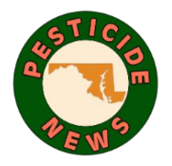Niranjana Krishnan, Assistant Professor and Maryland Pesticide Education Coordinator | nkrish@umd.edu @umd.edu
University of Maryland, College Park
 In July 2023, the EPA posted 10 years (2013-2022) of pesticide incident data on its website. This was done to increase transparency and provide a better understanding of pesticide exposures, including exposures to vulnerable populations.
In July 2023, the EPA posted 10 years (2013-2022) of pesticide incident data on its website. This was done to increase transparency and provide a better understanding of pesticide exposures, including exposures to vulnerable populations.
- The published datasets allow users to access raw data on pesticide incidents such as the incident date, the reason for the report (e.g., adverse effect, product defect), and the severity of the incident. It may also include information on the location of the incident, the pesticide product, and a description of the incident. However, the EPA has not verified the raw data for accuracy or completeness.
- The EPA received information on pesticide incidents from pesticide manufacturers, state regulators for pesticide enforcement, individual emails, the National Pesticide Information Center, and American Association of Poison Control Centers.
- Prior to this, the EPA only provided incident information to the public when responding to requests under the Freedom of Information Act or as an incident summary during the pesticide re-registration process. The EPA will now update the data monthly going forward.
- Below is a summary of reported pesticide incidents from Maryland (2013-2022).
| Group | Incidents | Number of incidents | Pesticides involved |
| Humans | Mortality | 3 | Disinfectants hydrochloric acid and bleach and insecticide chlorfenapyr |
| Major effects1 | 10 | Primarily, insecticides (mostly pyrethroids) and herbicides | |
| Moderate effects2 | 160 | Primarily, insecticides and disinfectants | |
| Minor effects3 | 10 | Primarily, insecticides and disinfectants | |
| Domestic animals | Mortality | 10 | Insecticide fiprinol (with methoprene) and rodenticide bromethalin |
| Major effects1 | 3 | Primarily, insecticides and rodenticides | |
| Moderate effects2 | 9 | Primarily, insecticides and rodenticides | |
| Minor effects3 | 6 | Primarily, insecticides and rodenticides | |
| Wildlife | Major effects4 | 6 | Insecticide carbofuran, rodenticide bromadiolone, and algicide copper |
| Minor effects5 | 5 | ||
| Plants (incl. lawns) | Major effects4 | 70 | Primarily, herbicides (dicamba, 2,4-D, mecoprop, etc.) and insecticides (bifenthrin, malathion, deltamethrin, etc.) |
| Minor effects5 | 190 |
- Includes life-threatening symptoms or residual disability.
- Includes pronounced or prolonged symptoms. Usually, some form of treatment would have been indicated. Individuals can return to a pre-exposure state.
- Includes minor symptoms that resolve rapidly (e.g., skin, eye, or respiratory irritation).
- Affects many individuals (wildlife) or large acreage (plants).
- Affects few individuals (wildlife) or small acreage (plants).
Reference: https://www.epa.gov/pesticides/epa-posts-pesticide-incident-data-publicly
